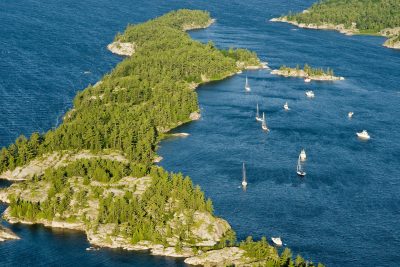Victory for Canada’s First Nations: Saugeen Ojibway Nation Has Saved Lake Huron from a Nuclear Waste Dump

A major victory for Canada’s First Nations has just been won in Ontario. On January 31, the Saugeen Ojibway Nation (SON) overwhelmingly voted down the proposed deep geological repository (DGR) for storage of low- and intermediate-level radioactive nuclear waste next to Lake Huron. The DGR had long been proposed by Ontario Power Generation (OPG), but in 2013 OPG had committed to SON that it would not build the DGR without their support.
As Chief Lester Anoquot of the Chippewas of Saugeen First Nation told the press on January 31,
“This vote was a historic milestone and momentous victory for our People. We worked for many years for our right to exercise jurisdiction in our Territory and the free, prior and informed consent of our People to be recognized.” [1]
Out of 1,232 total votes, there were 4 spoiled ballots, 170 yes votes, and 1,058 no votes, indicating that 85% of those casting ballots had said no to a DGR at Bruce Power’s nuclear generating station in Kincardine, Ont.
Dr. Gordon Edwards, a long-time nuclear critic, has advocated a “policy of Rolling Stewardship” by which the wastes would be “constantly monitored and kept in a retrievable condition [above-ground] indefinitely,” as they are now.
According to BeyondNuclear.org, the SON had been offered $150 million by OPG “in exchange for SON agreeing to ‘host’ this DGR” [2] It cannot have been easy for a small First Nation to reject this much money, so the rest of us might consider ways to thank them. After all, there are 40 million people (on both sides of the Canada-U.S. border) who obtain their drinking water from the Great Lakes.
A brief summary of the sordid history of the DGR proposal shows just how much thanks are owed the SON.
Sordid History
In 2001, Bruce Power was hived off from provincial Crown corporation OPG by the Conservative Mike Harris provincial government to become a private power company, leasing the eight Bruce nuclear reactors from OPG under a public-private partnership (P3). Bruce Power’s two major sharehholder-partners have long been TransCanada Corporation (now called TC Energy) and Borealis Infrastructure (the investment arm of the Ontario Municipal Employees Retirement System – OMERS). The Bruce site’s assets (including the nuclear waste) remain owned by OPG, while Bruce Power gets the profits from selling the nuclear-generated electricity. [3]
In the same year that this P3 was established, the Kincardine City Council approached OPG about hosting a possible long-term nuclear waste facility. OPG’s proposal was to bury low- and intermediate-level nuclear wastes from Ontario nuclear power plants in chambers drilled into limestone 680 metres (2,231 feet) below the surface and under the Bruce nuclear site at Kincardine – 400 metres from Lake Huron. The nuclear waste to be entombed in the DGR would come from the Bruce, Pickering and Darlington nuclear sites in Ontario – currently home to 18 Candu reactors.
After years of controversy, a Canadian federal Joint Review Panel (JRP) approved the DGR in May 2015, accepting testimony that Lake Huron would be large enough to dilute any radioactive pollution that might leak from the DGR. [4] This outrageous “environmental” ruling prompted thousands of people on both sides of the Canada-U.S. border to mobilize, and dozens of communities adopted resolutions against the DGR. Meanwhile, U.S. efforts to engage the International Joint Commission (IJC), which oversees boundary waters’ issues, had gone nowhere.
In 2015, I contacted the IJC’s Public Information Officer Frank Bevacqua, who told me by email that both the Canadian and U.S. federal governments would have to ask the IJC to intervene on the issue. “The IJC does not review proposals for site-specific projects [like the DGR] unless asked to do so by both governments,” he said. [5] Obviously, it was the Canadian federal government that was the hold-out.
Nonetheless, after the Harper government’s JRP approval, subsequent Canadian federal politicians have been reluctant to give final approval to the DGR, perhaps knowing how much that would enrage people and politicians on both sides of the border. In August 2017, then-environment minister Catherine McKenna was the latest to pause the process, “to ensure buy-in from Indigenous people in the area.” [6]
Money Talks (For Some)
In March 2013, an NGO called Stop the Great Lakes Nuclear Dump reported that
“OPG is paying $35.7 million to Saugeen Shores, Huron-Kinross, Arran Elderslie, Brockton [and] Kincardine. All are [municipalities] adjacent to the Bruce Nuclear Power Plant site. Ten and a half million dollars have already been paid even before approval to construct the dump is received.” [7]
Erika Simpson, political science professor at the University of Western Ontario, also noted at the time that the payments to these municipalities will continue for years “so long as they provide their co-operation in support of the environmental approvals and licensing applications…” [8]
In contrast to these municipalities, we now know that the Saugeen Ojibway Nation passed up $150 million from OPG and voted down the DGR. Let’s find ways (including financial) to show our gratitude. The mailing address for Saugeen Ojibway Nation’s Environmental Office is 25 Maadookii Subdivision, Wiarton, Ontario, Canada N0H 2T0.
*
Note to readers: please click the share buttons above or below. Forward this article to your email lists. Crosspost on your blog site, internet forums. etc.
Joyce Nelson is the author of seven books. She can be reached via www.joycenelson.ca
Notes
[1] Saugeen Ojibway Nation Environment Office, “Vote Results,” January 31, 2020.
[2] Beyond Nuclear.org, January 30, 2020.
[3] Joyce Nelson, “Nuclear Dump Controversy,” Watershed Sentinel, September 17, 2015.
[4] Joyce Nelson, “Great Lakes Nuclear Waste Dump: The Battle Continues,” Counterpunch, January 15, 2016.
[5] Quoted in ibid.
[6] Colin Perkel, “Indigenous community votes down proposed nuclear waste bunker near Lake Huron,” The Canadian Press, February 1, 2020.
[7] Quoted in Nelson, “Nuclear Dump Controversy,” op. cit.
[8] Quoted in Ibid.

